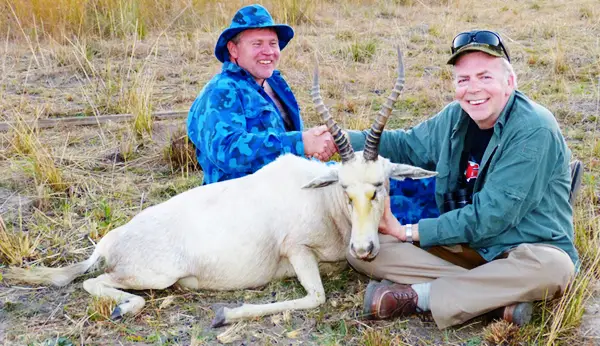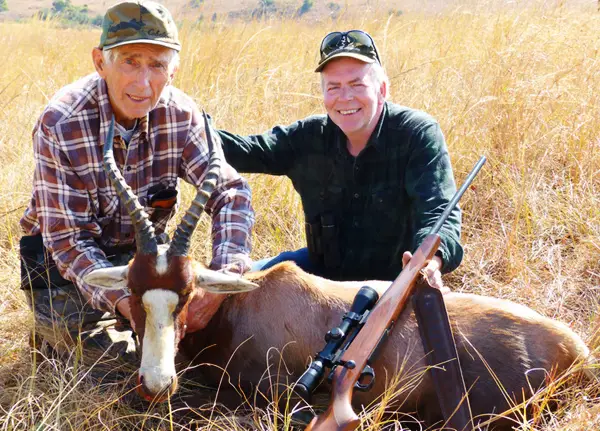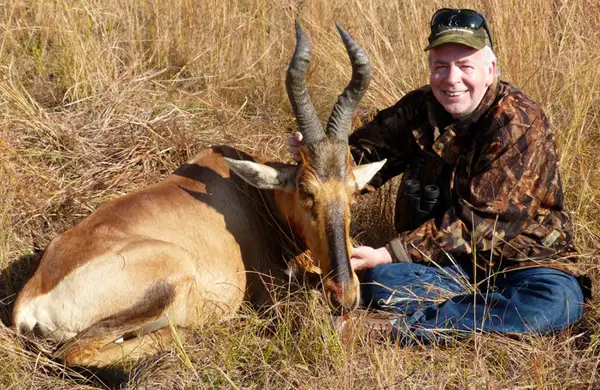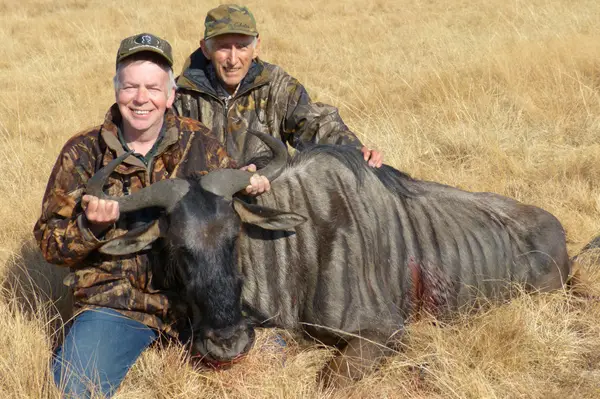|
Return to South Africa  South African landscape. Photo by Randy Wakeman. Non-hunters, unfortunately, often have little understanding about nature and the way the world works. Historically, in the United States, hunters have been the greatest champions of conservation: without the funding provided by hunters, many game animals would have long ago ceased to exist. No one cares more about healthy, vibrant game populations than the hunter for self-explanatory reasons. The landscape of the United States has changed dramatically over the years. In the 1870's an estimated 70-80% of the country was employed in agriculture, which is no longer the case. According to the last census of agriculture in 2007, the average farm in the United States comprises 418 acres, and only 2-3% of American workers are directly employed in agriculture. Yet, farmland still accounts for 75% of wildlife habitat in the U.S. Hunting is still popular, actually on the rise in the United States for the first time in many years, but it expensive and largely controlled by our giant government. Hunting licenses alone for non resident hunters for just whitetail deer have hit up to $473.25 in my home state of Illinois and $551 in neighboring Iowa. Arizona for non-residents has hit a whopping $609.25. This is just for a license; it hardly means that you have any quality place to hunt. The United States federal government also taxes firearms and ammunition. That's just the tip of the old iceberg, for the federal government kills some 100,000 carnivores every year under the U.S. Department of Agriculture’s (USDA’s) Wildlife Services program: killing bears, wolves, coyotes and mountain lions. Whatever it is, it is hardly “natural.” The United States has some 30 million deer, over one hundred times the population 100 years ago: our deer herds and their habits can hardly be considered natural, either. In the United States, the menace to deer can be vegetarians with automobiles, for vehicle-deer collisions kill 200 Americans and cost $4 billion dollars a year, according to Insurance Journal. The deer generally don't fare well, as most people do not practice good Toyota-whitetail impact placement. All this is mentioned as a prelude to discussing South Africa, why everyone should go and what a tremendous bargain it is for many hunters in the grand scheme of things. With a far larger percent of the South African population involved in agriculture, there are comparatively huge tracts of land that are sometimes difficult to farm, but conducive to wildlife. One area that we hunted was something like 22,000 acres (over 34 square miles), that was all tall grass and wild animal; no farming, no cattle, no farm animals or row crops. As more and more people are becoming aware of the health benefits of consuming wild game, the value of wild game meat has increased proportionately. The hunter that dispatches his quarry instantly should take great pride in doing so, for nature's plan often isn't nearly as respectable. An old animal, with its teeth worn down below the gum-line starves to death, if he is not eaten alive by jackals and so forth. South Africa is a wonderland for the hunter and nature-lover alike. Preparation I can't speak for shooting enthusiasts from other nations, but in the United States many hunters don't bother to spend much time practicing, instead shooting off of lead-sleds or with sand bag and cradle, which is helpful for testing rifles or deciding what cartridge your gun prefers, but is exactly what you aren't going to be doing during your hunt. Shooting off of sticks, off-hand, or perhaps on your belly might be what the situation dictates. If we don't practice that stuff, there is no way we can become proficient at it. If you practice using hunting shooting stances at the ranges at which you will be hunting, you'll be glad you did. It invariably pays big dividends. Your best source of information is your professional hunter. This time, we were hunting middleveld that included blesbok, impala and red hartebeest with perhaps the odd chance at bushpig. The second area on the itinerary was pure tall grass, including red hartebeest, springbok, Cape buffalo, blue wildebeest, black wildebeest, eland, waterbuck, gemsbok and some introduced fallow deer. South Africa requires “proof of ownership” of the rifles you bring into the country, but no such thing exists in the United States. So, we went to Customs and Border Protection in Chicago, Illinois, where we had our rifles inspected and left with stamped “Customs Form 4457.” Overseas, that serves as your “American Gun Permit.” It is also requisite for bringing your rifle back into the United States. Note that autoloaders and slide actions are generally frowned upon by the South African government. Laws may change, but it is good idea to check with your PH on what the current environment allows. I'd consider good binoculars and a good laser rangefinder requisite. Everyone has their personal preferences. I like 8x42 binos for the large exit pupil in low light, but that wasn't the primary issue here. When walking and stalking, 8x magnification binoculars are quicker and easier for me to use than shakier 10x binoculars. I've settled on the Leupold RX-1000i as my standard rangefinder; my Dad still uses an older Leica model that has given good service. Dad and I both brought 270 Winchester bolt-action rifles. With the proper bullet and good shot placement, the .270 is sufficient for most big game. Anticipated shooting ranges were at least 300 yards, actually limited only by your good judgment in many cases. Personally, I do have a personal affinity for the 270 Winchester, as it has done well for me on everything from pronghorn and caribou to Newfoundland moose. It is one of many choices, though, and whatever you are comfortable with from the various .270, 7mm and .30 caliber cartridges on up is perfectly reasonable for all the animals I've mentioned, with the exception of buffalo. My Browning X-Bolt grouped quite well with 130 grain Hornady InterBond Superformance cartridges, inside an inch at 200 yards, so that's the rifle that got the nod. Dad used a Weatherby Vanguard Series 2, along with a cartridge it liked, the Federal Trophy Copper 130 grain load. Flat shooting cartridges make shot placement easier, particularly with variable winds. The Hornady Superformance load boasts just 5.7 inches of drop between 200 and 300 yards from a 24 inch barrel and just slightly more from the 22 inch barrel of the Browning X-Bolt. Your best asset of all is your professional hunter. We had hunted with Karel Haefele of Ke Monati Safaris before and cannot sing his praises too highly. Arrival and Rifle Confirmation Be sure to bring along a big package of patience with you when trying to retrieve your firearms from the “Constables” at Johannesburg Airport (Tambo International). They truly have no clue and seemingly take delight in making the process as tedious and time-consuming as possible. Airlines vary greatly in the way they handle, delay, abuse, or lose checked baggage. There are no guarantees, to say the least, so the first order of business is to confirm the sighting of your rifle. It has happened with air travel in the U.S., Canada, Argentina, you name it, and it has happened in South Africa. All a professional hunter can do is get you within range of a quality animal. It is up to you to get a good bullet in the right spot, so we need to eliminate the possibility of rifle or scope damage, as if the hunt depended on it. That's precisely the case, for if we fail to put the bullet where it belongs, it is all a waste. Lufthanza was especially nice to me, as they didn't trash my rifle on the trip over; they were kind enough to wait until the return trip to inflict their damage. Blesbok Blesbok are grazers, as opposed to browsers or leaf-eaters, preferring the short grass. They are herd animals and can be quite difficult to stalk. They certainly were for Karel and me, for we were busted again and again during many miles of approaches. Even using the bushes, dips in the terrain and so forth, they often hit the road before we could get within five of six hundred yards. There are hundreds of sets of eyes, including impala in the same area, so when one animal decides to spook, often they all go. You might have heard the term “plains game” used, although there really is no such thing. It is a confusing term. The last time we hunted South Africa we were in Bushveld. The three broad categories of South African hunting terrain are Bushveld, Middleveld and Highveld. Veld, loosely translated, means field. This time, we hunted Middleveld which included both tall and short grass, mountains, streams, ponds, rocks and some trees and bushes. The second area we hunted was all Highveld, almost exclusively tall grass in flat fields without much cover beyond dips and rises in what is primarily wide open grassland. The first evening, after confirming our rifles, we hit the Middlevelt and although we saw thousands of animals, we didn't get within 350 yards, except for a very late sunset stalk. July is winter in South Africa, although it wouldn't meet the North American view of cold weather. At night, temperatures got into the low thirty degree F. range, approaching the freezing point, but the days were in the middle 70's to lower 80's, gorgeous and sunny. The second day, after countless attempted approaches, we did get within 325 yards of a large group of common Blesbok with a couple of very nice rams. Although both male and female Blesbok have horns, the male horns have far more mass. However, at 600 yards most people would be hard pressed to tell. Even at closer ranges, it takes a while to be able to quickly pick up on the differences. Anyway, the sticks went up, the X-Bolt was on the best ram, the safety was off, the finger was on the trigger. The Blesbok were starting to spook, thanks to an impala herd and the wind had picked up, so given a raking shot at a moving animal with a crosswind right at 340 yards, it was decision time. I decided not to hit the switch, though that Blesbok ram will never know how very close it was. We skipped our planned brunch and kept on hunting. Late in the day we spotted a smaller group of Blesbok with two white Blesbok rams, one of which looked to be quite good, at least from a distance. Karel and I were able to get into good position, so we could do our stalk through the tall grass with the wind in our faces, moving downhill. Karel spotted the ram first, just small patch of white from his back through the tan grass. I couldn't see him at first, as I was looking farther out, but I finally picked up the white patch. We moved a bit closer and the sticks went up in the wind. We were almost sure it was the one, but we weren't completely sure. We had to wait to see if he would pick up his head for a final look. He did, his head just above the tall grass, although he was working through the short pasture area with new growth. Once verified, that was it and a shot rang out a fraction of a second later. Some animals shrink when they hit the ground, a lesser number tend to grow. This white Blesbok grew, quite a bit actually, for the horns were 16-1/2 inches or so, substantially better than we thought. The Rowland Ward record book minimum is 16-1/2 inches for a Blesbok, so this one is going to be extremely close. The white Blesbok ram took zero steps and the 130 grain Hornady Interbond created a huge wound channel, the lungs turned instantly into gel. It was very good expansion on what is a medium sized African antelope. A Blesbok is perhaps half again the size of a Springbok, maybe marginally heavier than an impala, but nowhere near the size of a red Hartebeest, which can hit 330 pounds. In any case, this Blesbok is making a beautiful trophy and was a satisfying start to this year's hunt. 
Karel (left) and I with my white blesbok. As you might imagine, opinions vary as to what game tastes the best. Karel feels Blesbok makes some of the finest biltong. Many feel that both Springbok and Eland offer the best steaks; we had both Kudu and some fresh red Hartebeest while we were there and found them both delicious. Like many things, it has to do with how the meat is handled and prepared, as much as anything else. Nothing goes to waste on a South African game animal. You see this again and again. If not for hunters, there would be no preservation and restoration of natural habitat, as no one cares more about healthy game populations than the hunter. Hunters take old animals, almost exclusively old males, a far better fate than what nature has planned for them Animals like this, after wearing out their teeth, tend to starve and weaken until the jackals can start to chew on them alive. It is a far more respectable end for a beautiful animal; to live a long and healthy life, ended in a split second and revered, rather than the harsh death that nature has in store for them. I'm quite proud to be a hunter; we all should be. The next day, my favorite hunting buddy (disguised as my eighty-five year old father) got his chance at a nice Blesbok. A large herd was spotted and we set up across a rocky stream behind a stand of trees. We had a volunteer to move them, not an arduous task, as the Blesbok had been very wary. We hoped that part or all of them might head to the popular pasture grazing area that we were near, but of course they could go anywhere they wanted. Sometimes, it is better to be lucky than good. I'll take the lucky most every time. 
Dad and I with his blesbok. Although as far from a certainty as there can be, the Blesbok cooperated in part. While not moving to the area where we thought, they moved within range and there was an excellent ram in the group. Dad did the rest with a single shot from his Weatherby Vanguard Sporter. Red Hartebeest On our five or six mile trek of Blesbok approaching, we tried to zone in on two good Red Hartebeest bulls spotted earlier in the day. Professional Hunter Karel had a plan, but this time the plan didn't work out as hoped. One large bull was alone; the other was with a small group of females. We hiked and climbed up the rocky hills to where we thought they were headed, but the Hartebeest apparently had different plans, plans of their own. Although there were over one hundred fifty head of hartebeest in various groups that we had already glassed, at the end of the day they all completely vanished. I guess that's what you should expect from an animal that looks like an Egyptian god of malicious mayhem, something to which, with the proper robes, Yul Brynner could have spent time praying. A bigger antelope than a Blesbok, they are in the 330 pound range and all muscle. Visually stunning and distinctive, they are perhaps my favorite African game animal and they also do quite well on the dinner plate, as we can personally attest. Though the disappearance of all the Hartebeest remains a mystery, the next morning Karol had a plan. It is always good to have one, even if it doesn't work. This time, we spotted what seemed to be the same group of six or seven animals moving through the tall grass up into the hills, but we couldn't be sure. It was time to try to get ahead of them, doing a little rock climbing to see if they ended-up where they were supposed to. On the overlook on top of the hill, there they were. We were well-covered by brush and I crawled on my belly to the first of two larger rocks, still cloaked by grass and brush. Karel slid my rifle down to me and now it was a matter of finding the big bull we had seen the day before. He was there alright, with his butt towards us, grazing away in the tall grass, inside two hundred yards. There was some wind, but it was manageable. Although there was no rush, according to Karel, actually there was a bit of a complication. The bull moved to the right, I was shooting through grass as it was and the shooting window was narrow. Just a few more steps to the right and the opportunity would be gone. When you have “the” bull in front of you, at last, with the safety off and the scope on him, moments can seem like hours. Ideally, he would pose broadside, but there was no guarantee. He started to turn a couple of times, sticking his neck in the right direction, but quickly returned to the narrow raking shot angle. It was the same type of shot I had passed up on the Blesbok ram the day before, although the wind was far stronger, the distance greater, the Blesbok was moving and was a smaller target, as well. The Hartebeest bull had no clue we were there, going straight down with an InterBond through the center of his neck. The next order of business was figuring out how to get to him, which we eventually resolved. 
My red hartebeest. It was another fabulous guiding job by Karel Haefele, a fine trophy, and a memorable hunt. A couple of days later, at a completely different 22,000 acre prairie hunting area, my 85 year old father put a bullet in the right place and dropped his Hartebeest trophy. Blue Wildebeest The blue wildebeest, more correctly the brindled gnu or black-tailed gnu, can hit eight feet in length head to rump, up to 4.8 feet tall at the shoulder and weigh around 640 pounds. While it may look like a crazed, strange, maverick cow, it is an antelope. The sub-family Alcelaphinae is a group of large, nomadic antelope native to Africa. The brindled gnu is related to red hartebeest and the blesbok, which are also from the Alcelaphinae sub-family. They may look clumsy, yet they have been clocked running at over 50 miles per hour. If you've watched some of the nature documentaries, you might think that most everything eats the wildebeest; certainly lions, cheetahs, jackals, hyenas and crocodiles do. With their synchronized birthing, 500,000 wildebeest calves are born over a 2 to 3 week period in February. The calves can stand within six minutes of birth and follow their mother within 15 minutes, so nature has deployed some very effective countermeasures here. Wildebeest take part in what is considered to be the largest migration of large land mammals in the world. The zebra coexists well with the wildebeest, eating the same plants, but different parts. Zebras, or “pajama donkeys” as Karel calls them, with their better sight and hearing, can effectively sound the alarm for the wildebeest. They have been given the moniker of the “Poor Man's Buffalo” and their meat is highly valued. The dark humor about the wildebeest is that they are born sick and get healthier with every lead pill that hits them. They are tough, well-muscled and tenacious animals. Yet, some of the ideas about the cartridge needed to achieve a quick, clean wildebeest kill are wacky. An appropriate bullet at its working velocity in the right spot invariably does the job. A bullet in the wrong spot doesn't work well. I was looking forward to using my .270 Winchester on a brindled gnu, with the load that shot the best out of my X-Bolt, the 130 grain Hornady Superformance InterBond. On the last full day of hunting, Karel managed to get us inside 300 yards of an excellent old brindled gnu bull. He was broadside and the shot was a complete pass-through. The wildebeest was already dead, but didn't know it until a few moments later, when he died on his hooves. 
Me and Dad with my blue wildebeest. The Hornady 130 grain InterBond that had already displayed impressive expansion on the much lighter white Blesbok, did a superlative job on the wildebeest. This bullet made a large wound track the entire width of the animal with more penetration than needed, as the bullet exited. Conclusion It is hard to ask for a better hunting experience. We thoroughly enjoying being with countless thousands of wild animals of all types. We fired a grand total of five shots, resulting in five memorable trophies. Superlatives are perhaps given out a bit too freely, but in the case of Karel Haefele and Ke Monati Safaris, it is richly deserved. We hunted with Karel in 2006, he was outstanding then and he is, if possible, even better now. If I go back to the same professional hunter, you can believe he is better than just good. You can do no better than to say yes to adventure and plan your next hunt with Karel Haefele. |